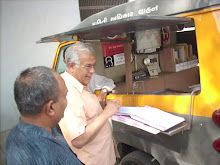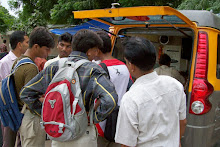The Hindu: New Delhi: Monday, May 21, 2012.
Pranab Mukherjee's stirring call for austerity tugs at the national tear ducts. Prime Minister Manmohan Singh has pleaded for it in the past and watched his flock embrace it creatively. With the Finance Ministry even acting on Dr. Singh's call in 2009 (economy class air travel, spending cuts), we are now in the fourth year of our noble quest.
There are, of course, several kinds of austerity. My pick would be the variety practised by Planning Commission Deputy Chairman Montek Singh Ahluwalia. No one can challenge Dr. Ahluwalia's commitment to austerity. Look at the way he's stood up to the populist demand for a poverty line that makes sense. No pampering people here. Spend Rs. 29 a day in urban India or Rs. 23 in rural India and you are not poor. He's even asked the Supreme Court to uphold the imposition of such rigour on hundreds of millions of his fellow citizens. One affidavit filed by the Planning Commission defended a line of Rs. 32 (urban) and Rs. 26 (rural) a day. Since then, the Padma Vibhushan awardee and some of his colleagues have stuck their necks out to lower that further.
RTI queries:
That Dr. Ahluwalia practises austerity himself is evident from two RTI queries. Both fine examples of RTI-based journalism, but failing to get the attention they deserved. Both exploring the anatomy of his austerity. One was a story in India Today (covering Dr. Ahluwalia's foreign trips between June 2004 and January 2011) by Shyamlal Yadav. This journalist (now with The Indian Express), has done outstanding RTI-based stories in the past as well.
The other, in February this year, came from The Statesman News Service (reporter unnamed). This one took out details on Dr. Ahluwalia's global forays between May and October 2011. In that period, he undertook “four trips covering 18 nights [which] cost the exchequer a sum of Rs. 36,40,140, an average cost of Rs 2.02 lakh a day,” says the SNS report.
At the time this happened, that Rs. 2.02 lakh would have been worth $4,000 a day. (Gee! Lucky for us Montek was into austerity. Imagine what his expenditure might have been otherwise). That is a daily spend almost 9,000 times greater than the 45 cents cut-off point at which rural Indians would be doing okay, in his view. Or over 7,000 times greater than the 55 cents cut-off point for urban Indians that Dr. Ahluwalia would find “normatively adequate.”
Now his spend of Rs. 3.6 million (or $72,000) in 18 days might well have been his personal stimulus to global tourism in that year. After all, the industry in 2010 was still recovering from the ravages of 2008-09, as the United Nations World Tourism Organisation points out. The U.N. agency found, on the other hand, that 2011 saw global travel revenues cross $1 trillion. The largest revenue increases were seen in the U.S. and Europe (where most of those 18 days were spent). The Indian public can rejoice over its money playing a humble part in that recovery even while scorched by austerity at home.
The stats from the Shyamlal Yadav's RTI are fascinating. To begin with, his findings show Dr. Ahluwalia made 42 official foreign trips and spent 274 days overseas during a seven-year tenure. That is “one in every nine days” abroad. And that's excluding travel days. The India Today story found that his excursions cost the exchequer Rs.2.34 crore. However, it points out that they received three different estimates of the costs of his trips and charitably went with the lowest. Also, said the India Today story, “it is not clear whether the figures include the expenses incurred by Indian embassies abroad on frills such as hiring limousines. The actual costs could be a lot higher.”
Since the post he holds does not require so much foreign travel all of it done, though, with “the permission of the Prime Minister” this is puzzling. That 23 of the 42 trips were to the U.S., which does not believe in planning (but then, perhaps, neither does Dr. Ahluwalia), is even more puzzling. What were these trips about? Spreading global awareness on austerity? If so, we'll have to spend more on his travel: look at those revolting Greeks killing the Cause on the streets of Athens. And even more on his trips to the U.S. where the austerity of the affluent is striking. CEOs in that country took home billions in bonuses even in 2008, the year Wall Street tanked the global economy. This year, even the media journals of the super-rich in the U.S. write about CEOs destroying their companies, jobs and more — and gaining personally from it. Millions of Americans, including many who suffered home mortgage foreclosures, saw a different kind of austerity. The kind the French increasingly fear and have voted against.
When Dr. Singh pleaded for austerity in 2009, his Cabinet rose handsomely to the call. Each member added a modest million rupees a month thereafter, on average, to his or her assets over the next 27 months. All the while, hard at work as Ministers. (“The Union Cabinet gets healthier,” The Hindu, September 21, 2011). Praful Patel excelled, adding on average, half-a-million rupees to his assets every 24 hours in that period. Workers in Air India, under a Ministry he headed much of that time, struggled to get their salaries for weeks on end. Now with Pranab cracking the whip, there'll be even more austerity going around.
Note the bipartisan spirit of this austerity: in the past few years, Praful Patel (UPA-NCP) and Nitin Gadkari (NDA-BJP) have hosted two of the costliest weddings ever, with far more guests than seen at any IPL final. Gender-balanced Spartanism, too. That was for Mr. Patel's daughter and Mr. Gadkari's son.
Their corporate counterparts take it further. Mukesh Ambani with his 27-floor (but higher than 50 storeys) costliest residence in living memory. And Vijay Mallya whose employees in Kingfisher struggle for their salaries who tweeted on May 5: “Having dinner at Atmosphere on the 123rd floor of the Burj Khalifa in Dubai. Never been so high up in my life. Awesome view.” That's probably higher than Kingfisher is flying right now. Both own teams in the IPL. Which body has received public subsidies (by way of entertainment tax waivers, for example). That is, until the matter went to the Bombay High Court. There are other public-funded austerities linked to the IPL watch this space.
Cont.........














































































